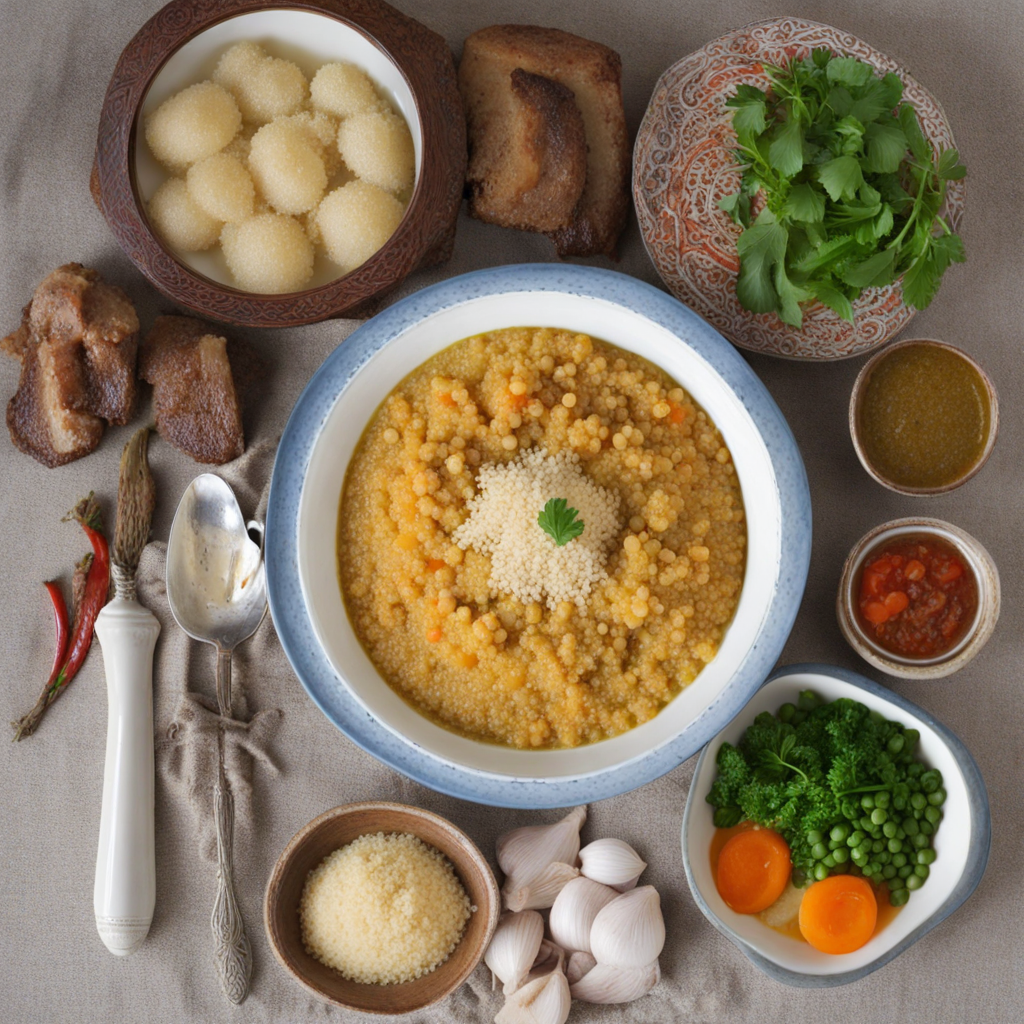Zgougou
Zgougou is a traditional Tunisian dish that reflects the rich culinary heritage of the region. It is made primarily from pine nut flour, which is finely ground from roasted pine nuts, giving the dish a unique nutty flavor and creamy texture. The dish is often sweetened with sugar and flavored with a hint of orange blossom water, which adds a fragrant aromatic note that enhances its overall appeal. Zgougou is typically served as a dessert, often during special occasions or festivities, making it a cherished treat among locals. The preparation of Zgougou involves mixing the pine nut flour with water and sugar, creating a smooth paste that is then molded into various shapes. Traditionally, it is adorned with a variety of toppings such as almonds, pistachios, and sometimes even edible flowers, which not only add to the visual presentation but also contribute additional flavors and textures. The combination of the creamy base and the crunchy toppings creates a delightful contrast that makes each bite a unique experience. One of the most fascinating aspects of Zgougou is its cultural significance. It is often associated with the celebration of the festival of the "Zgougou", which marks the end of the harvest period. During this time, families come together to enjoy this delicious dish, symbolizing unity and the sharing of abundance. For those looking to explore new tastes, Zgougou offers a delightful journey into Tunisian flavors, showcasing the harmonious blend of sweetness, nuttiness, and floral notes that characterize this beloved dessert.
How It Became This Dish
The Enigmatic Zgougou: A Culinary Treasure of Tunisia Origin and Historical Context Zgougou, a traditional Tunisian delicacy made from the seeds of the Aleppo pine (Pinus halepensis), has a rich and multifaceted history that intertwines with the cultural and agricultural heritage of Tunisia. The term "zgougou" itself is derived from the Arabic word "زقوقو," which denotes the seeds that are harvested from the cones of these distinctive trees. The Aleppo pine is native to regions surrounding the Mediterranean, including Tunisia, where it thrives in the coastal and mountainous areas. Historically, the Aleppo pine has been significant to the Tunisian landscape, not just for its timber and resin but also as a vital source of sustenance. The practice of gathering zgougou seeds dates back centuries, often linked to the local Berber communities who inhabited the mountainous regions of Tunisia. These communities utilized the seeds not only as a food source but also as a cultural symbol of resilience and resourcefulness, reflecting their deep connection to the land. Cultural Significance Zgougou is more than just a food item; it embodies the spirit of Tunisian culture. It is particularly associated with the celebration of the Day of Ashura, which occurs on the 10th day of Muharram in the Islamic calendar. On this day, many Tunisians prepare dishes featuring zgougou as a way to commemorate the martyrdom of Imam Hussein, the grandson of the Prophet Muhammad. The preparation of zgougou-based delicacies has become a ritualistic activity, bringing families together in a communal act of remembrance and celebration. The importance of zgougou extends beyond religious observance; it is also a symbol of national identity. In a country known for its culinary diversity, zgougou stands out as a unique ingredient that reflects Tunisia's agricultural bounty. The seeds are often ground into a fine powder and used in various sweet and savory dishes, such as zgougou cream (a sweet paste) and zgougou cake. These dishes are typically served during festive occasions, enhancing their cultural significance. Development Over Time The evolution of zgougou in Tunisia can be traced through various phases, influenced by social, economic, and agricultural changes. In the early 20th century, the collection and use of zgougou were primarily a rural practice. Families would gather the seeds by hand, a labor-intensive process that required skill and knowledge passed down through generations. This traditional method of harvesting ensured that zgougou remained a staple in the rural diet, particularly among Berber communities. As Tunisia underwent modernization in the mid-20th century, the role of zgougou began to shift. Urbanization led to changes in dietary habits, with many traditional foods being replaced by more industrialized options. However, zgougou retained its place in Tunisian culture, particularly during religious holidays and family gatherings. The post-independence period saw a resurgence of interest in traditional foods as a way to assert national identity and heritage, leading to a renaissance of zgougou-based dishes. In recent decades, zgougou has gained recognition beyond its regional roots. With the rise of culinary tourism in Tunisia, chefs and food enthusiasts have begun to explore and promote traditional ingredients like zgougou on a global stage. This revival has resulted in innovative interpretations of classic dishes, blending traditional flavors with contemporary culinary techniques. For instance, zgougou has found its way into gourmet desserts and artisanal products, captivating the palates of both locals and tourists alike. Culinary Uses and Preparation Zgougou is most commonly used in two forms: as whole seeds and as a finely ground powder. The seeds have a nutty flavor and a slightly crunchy texture, making them versatile for various culinary applications. One of the most popular traditional dishes is "zgougou cream," which is made by mixing the ground seeds with sugar, water, and sometimes milk to create a sweet, thick paste. This cream is often enjoyed as a dessert or spread on bread, symbolizing comfort and indulgence. Another beloved zgougou dish is the zgougou cake, which incorporates the seed powder into a rich cake batter, often flavored with orange blossom or rose water. The cake is typically decorated with nuts, fruits, or additional zgougou powder, making it a centerpiece at celebrations. Additionally, zgougou is sometimes used in savory dishes, where its unique flavor can enhance sauces and stews. The preparation of zgougou-based foods is often a communal activity, with families coming together to share recipes, techniques, and stories. This collaborative approach fosters a sense of community and continuity, ensuring that the culinary traditions surrounding zgougou are preserved for future generations. Conclusion Zgougou is more than just a food item; it represents the intersection of culture, history, and identity in Tunisia. Its journey from a traditional rural staple to a celebrated ingredient in contemporary cuisine reflects the resilience and adaptability of Tunisian culinary practices. As Tunisian society continues to evolve, zgougou remains a cherished symbol of heritage, connecting people to their roots and to one another. In a world increasingly dominated by globalization and industrial food systems, zgougou serves as a reminder of the importance of preserving local traditions and ingredients. Through its rich history and cultural significance, zgougou continues to inspire chefs, food lovers, and families alike, inviting them to explore the depths of Tunisian culinary heritage and to celebrate the flavors of this unique and enchanting land.
You may like
Discover local flavors from Tunisia







